
This notebook implements many of the examples presented in the paper.
import grama as gr
import numpy as np
import pandas as pd
DF = gr.Intention()
gr.hide_traceback() # To simplify errors shown in Jupyter
%matplotlib inlineGrama¶
Core Functionality¶
md_example = (
gr.Model("An example model")
# Overloaded `>>` provides pipe syntax
>> gr.cp_vec_function(
fun=lambda df: gr.df_make(f=df.x+df.y+df.z),
var=["x", "y", "z"],
out=["f"],
)
>> gr.cp_bounds(x=(-1, +1))
>> gr.cp_marginals(
y=gr.marg_mom("norm", mean=0, sd=1),
z=gr.marg_mom("uniform", mean=0, sd=1),
)
>> gr.cp_copula_gaussian(
df_corr=gr.df_make(var1="y", var2="z", corr=0.5)
)
)The model representation presents a helpful summary:
md_example/Users/zach/Git/py_grama/grama/marginals.py:336: RuntimeWarning: divide by zero encountered in double_scalars
model: An example model
inputs:
var_det:
x: [-1, 1]
var_rand:
y: (+0) norm, {'mean': '0.000e+00', 's.d.': '1.000e+00', 'COV': inf, 'skew.': 0.0, 'kurt.': 3.0}
z: (+0) uniform, {'mean': '0.000e+00', 's.d.': '1.000e+00', 'COV': inf, 'skew.': 0.0, 'kurt.': 1.8}
copula:
Gaussian copula with correlations:
var1 var2 corr
0 y z 0.5
functions:
f0: ['x', 'y', 'z'] -> ['f']Construct a default parameter sweep
(
md_example
>> gr.ev_sinews(df_det="swp")
>> gr.pt_auto()
)/Users/zach/opt/anaconda3/envs/evc/lib/python3.9/site-packages/plotnine/utils.py:371: FutureWarning: The frame.append method is deprecated and will be removed from pandas in a future version. Use pandas.concat instead.
Calling plot_sinew_outputs....
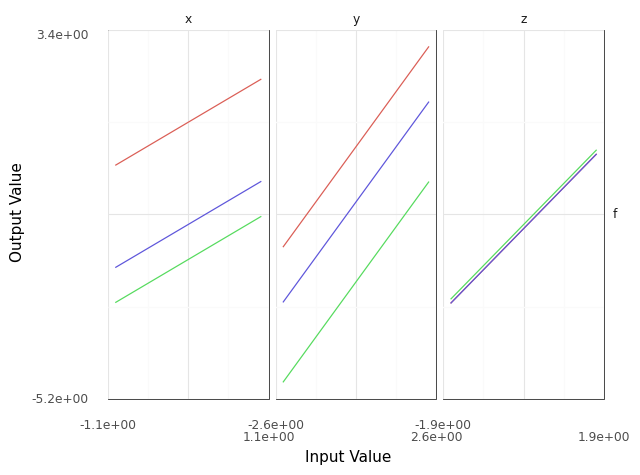
<ggplot: (8765340788697)>Function Defaults¶
Most concise form: Evaluate a model with default arguments, construct an automatic plot.
p = (
md_example
>> gr.ev_sinews(df_det="swp") # Default parameters
>> gr.pt_auto() # Default visual
)
p.save("example-sweep.png")Calling plot_sinew_outputs....
/Users/zach/opt/anaconda3/envs/evc/lib/python3.9/site-packages/plotnine/ggplot.py:719: PlotnineWarning: Saving 6.4 x 4.8 in image.
/Users/zach/opt/anaconda3/envs/evc/lib/python3.9/site-packages/plotnine/ggplot.py:722: PlotnineWarning: Filename: example-sweep.png
/Users/zach/opt/anaconda3/envs/evc/lib/python3.9/site-packages/plotnine/utils.py:371: FutureWarning: The frame.append method is deprecated and will be removed from pandas in a future version. Use pandas.concat instead.
Override the evaluation default to produce more sweeps.
(
md_example
## Override default parameters
>> gr.ev_sinews(df_det="swp", n_sweeps=10)
>> gr.pt_auto()
)Calling plot_sinew_outputs....
/Users/zach/opt/anaconda3/envs/evc/lib/python3.9/site-packages/plotnine/utils.py:371: FutureWarning: The frame.append method is deprecated and will be removed from pandas in a future version. Use pandas.concat instead.
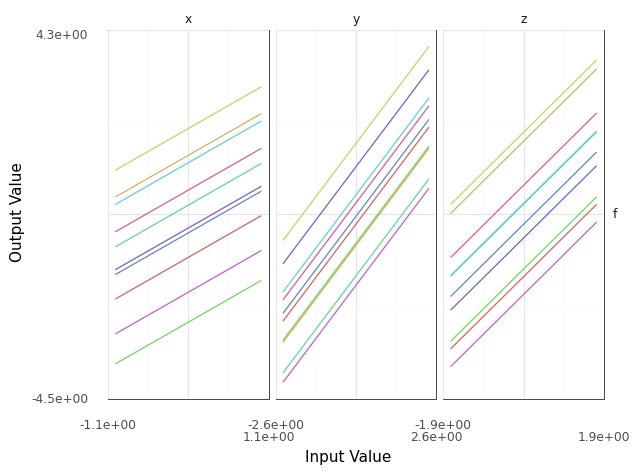
<ggplot: (8765323858170)>Override the autoplot to construct a more targeted manual plot.
(
md_example
>> gr.ev_sinews(df_det="swp")
## Construct a manual plot
>> gr.tf_filter(DF.sweep_var == "x")
>> gr.ggplot(gr.aes("x", "f", group="sweep_ind"))
+ gr.geom_line()
)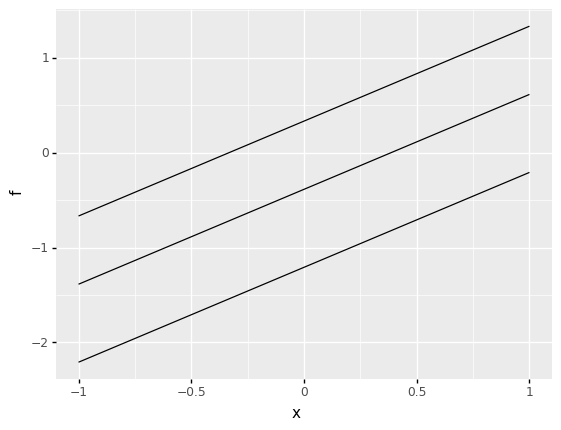
<ggplot: (8765332735501)>Case Studies¶
1. Planned Errors as Teachable Moments¶
It is possible to define a grama model without a copula:
md_flawed = (
gr.Model("An example model")
>> gr.cp_vec_function(
fun=lambda df: gr.df_make(f=df.x+df.y+df.z),
var=["x", "y", "z"],
out=["f"],
)
>> gr.cp_bounds(x=(-1, +1))
>> gr.cp_marginals(
y=gr.marg_mom("norm", mean=0, sd=1),
z=gr.marg_mom("uniform", mean=0, sd=1),
)
)
However, this flawed model will throw an error when used in a probabilistic analysis:
(
md_flawed
>> gr.ev_sample(n=1000, df_det="nom")
)ValueError:
Present model copula must be defined for sampling.
Use CopulaIndependence only when inputs can be guaranteed
independent. See the Documentation chapter on Random
Variable Modeling for more information.
https://py-grama.readthedocs.io/en/latest/source/rv_modeling.html
2. Encouraging Sound Analysis¶
A comparative example
Manual approach¶
## Manual coordination
# Model data
x_lo = -1; x_up = +1;
y_lo = -1; y_up = +1;
f_model = lambda x, y: x**2 * y
# Analysis parameters
nx = 10 # Grid resolution for x
y_const = [-1, 0, +1] # Constant values for y
# Generate data
data = np.zeros((nx * len(y_const), 3))
for i, x in enumerate(np.linspace(x_lo, x_up, num=nx)):
for j, y in enumerate(y_const):
data[i + j*nx, 0] = f_model(x, y)
data[i + j*nx, 1] = x
data[i + j*nx, 2] = y
# Package for visual
df_manual = pd.DataFrame(
data=data,
columns=["f", "x", "y"],
)(
df_manual
>> gr.ggplot(gr.aes("x", "f", group="y", color="y"))
+ gr.geom_line()
)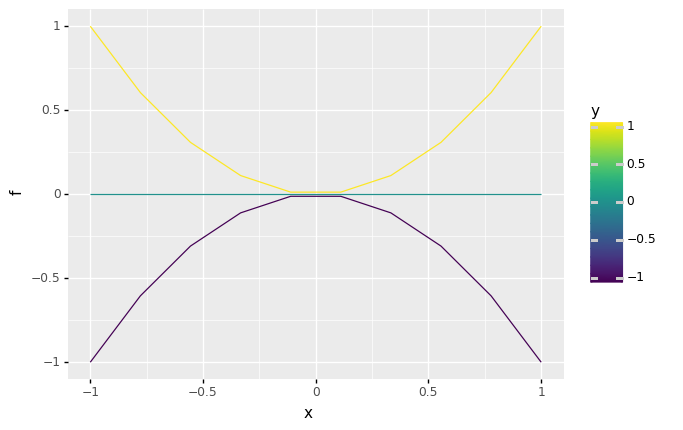
<ggplot: (8765362710010)>Grama approach¶
## Grama approach
# Model data
md_gr = (
gr.Model()
>> gr.cp_vec_function(
fun=lambda df: gr.df_make(f=df.x**2 * df.y),
var=["x", "y"],
out=["f"],
)
>> gr.cp_bounds(
x=(-1, +1),
y=(-1, +1),
)
)
# Generate data
df_gr = gr.eval_sinews(
md_gr,
df_det="swp",
n_sweeps=3,
)(
df_gr
>> gr.tf_filter(DF.sweep_var == "x")
>> gr.ggplot(gr.aes("x", "f", group="y", color="y"))
+ gr.geom_line()
)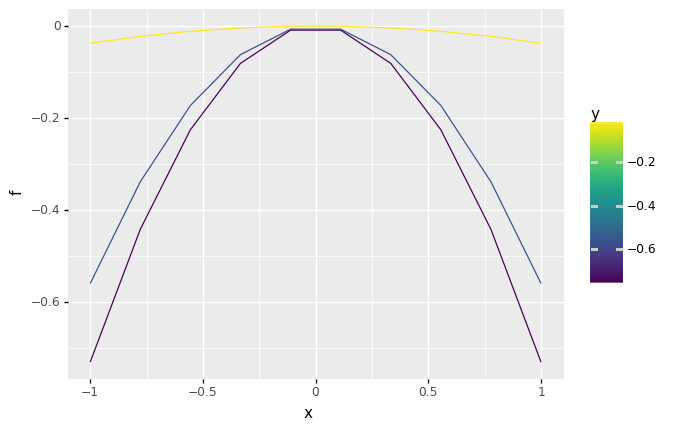
<ggplot: (8765332851008)>In-the-wild Example¶
md_car = (
gr.Model("Accel Model")
>> gr.cp_function(
fun = calculate_finish_time,
var = ["GR", "dt_mass", "I_net" ],
out = ["finish_time"],
)
>> gr.cp_bounds(
GR=(+1,+4),
dt_mass=(+5,+15),
I_net=(+.2,+.3),
)
)
gr.plot_auto(
gr.eval_sinews(
md_car,
df_det="swp",
#skip=True,
n_density=20,
n_sweeps=5,
seed=101,
)
)The following is the cropped form of the student parameter sweep, presented in the paper.
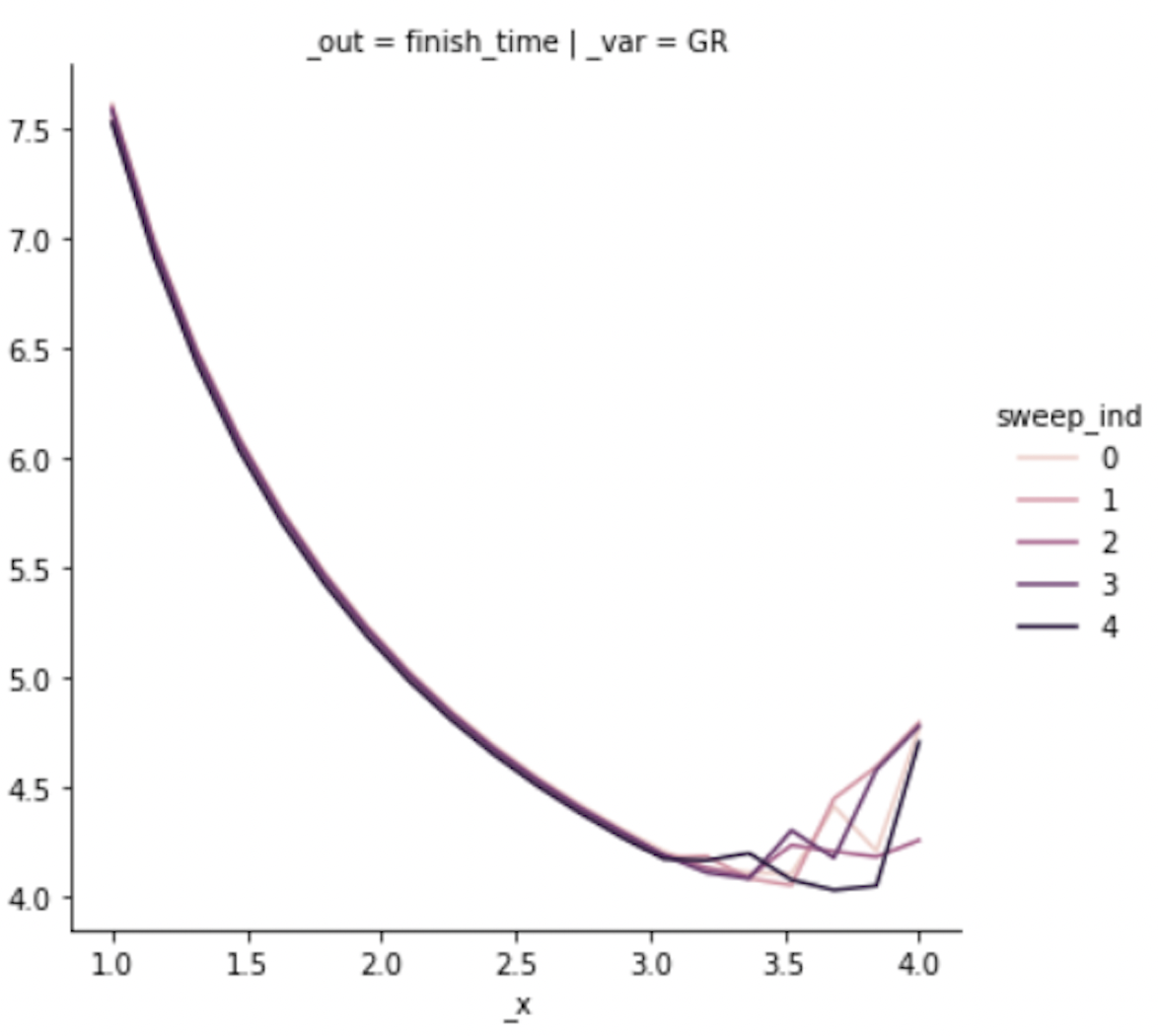
The following is the full version of the original student plot.

